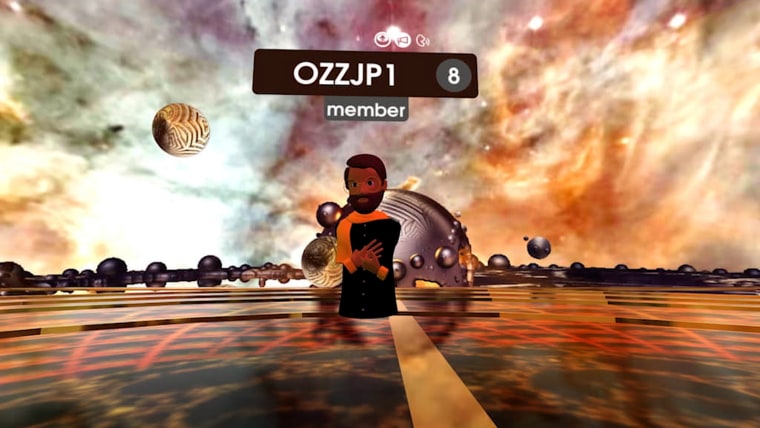After his father died of Covid last fall, Donkan Martinez was overwhelmed by grief and turned to an unlikely outlet: virtual reality.
The 24-year-old found himself wading into an emerging field of virtual mental health care, via a service called Innerworld, which offers peer-led mental health support through its app. The idea is to bring the principles of cognitive behavioral therapy, or CBT, into the metaverse and enable users to interact with others as anonymous avatars through voice- and text-based chat.
CBT aims to help patients change unhealthy thinking or behavioral patterns by developing relevant skills and coping strategies. The American Psychological Association describes it as a form of treatment that helps people “learn to be their own therapists.”
Innerworld, however, gives everyday users the opportunity to deliver support to one another. Its founder, Noah Robinson, emphasizes that the service should not replace professional treatment. Upon registering, Innerworld users must acknowledge that they understand the app is not therapy.
“It’s not therapy and we can’t provide crisis intervention,” Robinson said. “Our goal with Innerworld is to be a longer-term place that people can come to help them prevent themselves from getting to the point of being in crisis. Or we have people who are hospitalized who come out and are looking for additional support.”
Upon entering Innerworld, users can choose from a variety of settings that emulate environments like hiking trails or libraries. From there, they can engage with other avatars or browse a list of peer-led events, such as group meditation sessions, addiction support groups and workshops on navigating social anxiety. Martinez said that once, he joined a game in which users guessed what others were drawing.
The efficacy of Innerworld’s approach is unstudied, so gathering long-term data is crucial to evaluating this or any similar program, said Barbara Rothbaum, a psychologist at the Emory University School of Medicine. Rothbaum published a paper on the use of VR to treat a fear of heights in 1995.
“As far as virtual reality, most of the applications now have used a real therapist,” she said.
Indeed, most therapeutic uses of VR so far have centered on clinician-led exposure therapy for conditions like arachnophobia and claustrophobia, as well as for social anxiety and post-traumatic stress disorder.
However, Rothbaum added, “I do think [VR] could be useful for self-help, but the programs that have been tested haven’t been developed for that.”
Skip Rizzo, director of medical virtual reality at the University of Southern California Institute for Creative Technologies, said he first recognized VR’s potential for mental health uses in the 1990s. Rizzo helped pioneer the use of VR to treat PTSD among members of the military. A 2005 report documented the case of a Vietnam war veteran treated with VR therapy who experienced a 34% decrease in clinician-rated PTSD.

Rizzo said he sees the potential of Innerworld — as long as the app continues to make clear that it is not clinician-run.
“People that are worried about stigma around whatever the problem is that they have, or they’re ashamed, they might not want to admit to another person directly that they’re having these issues,” Rizzo said. “But they might be more likely to in an avatar-based world where they can preserve their anonymity but still interact with people.”
Martinez said he and other users he’s met on Innerworld felt they weren’t getting the empathy they needed in the real world.
“My real friends don’t know that I’m very emotional. I’m very conservative with my emotions with my real friends,” he said. “I’m able to open up in Innerworld because I know I’m not going to be judged. I’m not going to be attacked.”

Robinson said he was motivated to create Innerworld after finding solace in an online community in his own life. When he was 13, he said, he became depressed after realizing he was gay, and he turned to the online game RuneScape. The anonymity made him more comfortable exploring parts of himself he was afraid to face in the real world. Robinson said he eventually came out to his online friends.
Innerworld is not the only program attempting to use VR to help people access mental health support.
In his own work, Rizzo is piloting a clinician-facilitated VR project that offers social support to Ukrainian refugees. Refugees who have relocated to Bucharest, Romania, can enter a virtual version of a town square in Kyiv, where they can speak with fellow refugees as anonymous avatars.
A startup called BehaVR, meanwhile, launched its app, called First Resort, last week. The VR app guides users through “chapters” on skills that would be taught in CBT sessions.
Risa Weisberg, a professor at the Boston University Chobanian and Avedisian School of Medicine, is BehaVR’s chief clinical officer. She said that because people’s brains process VR experiences in the same way they would a real-life experience, “you don’t experience the interventions as something that you’re reading or hearing; you experience them as something that’s happening to you.”
Weisberg thinks that’s why VR exposure therapy has yielded results in the past.
VR’s reach could grow to 64 million people in the U.S. this year, according to a 2021 estimate by eMarketer. Weisberg said that expansion is occurring at a time when more people are seeking mental health care, but also as many are finding it inaccessible due to high costs.
“All that comes together at the same time to make the next few years really ripe for getting mental health techniques and interventions in VR,” she said. “I think we’re going to see a huge uptick in this.”
Rizzo said his main concern about Innerworld, however, is that people who need professional help might try to substitute the app instead. Rothbaum, meanwhile, said much more research is needed to determine whether these types of programs really work. Ideally, she said, there should be clinical experiments with control groups that track users’ outcomes.








